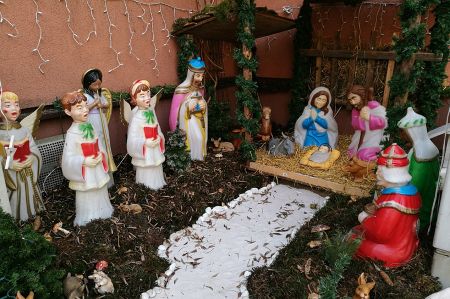History and - Mainbernheim is ready for Christmas too!
- Written by Portal Editor
We used our tour through the town of Mainbernheim near Kitzingen not just to explore the medieval fortifications of the city, of course, as well to look at the Christmas customs and Christmas decor, which is found in the windows, at the doors and many facades of the house.
Sometimes it is "just" an Advent wreath that is decoratively attached to a house entrance gate, then a whole ensemble of elements along a façade, here also ecologically appropriate to the overall building impression.
The Advent wreath with its four candles is intended to point to the light that came into the world with Christ, during the years the originally evangelical custom of the Advent wreath also entered the Catholic Church. In 1839 the Protestant theologian Johann Hinrich Wichern (1808-1881) had a wooden chandelier with 23 candles suspended for the first time, as far as is known, 19 small reds for the workdays until Christmas, four thick white for the Sundays. Even in the Eastern Churches, the Advent wreath in between is now partially taken over and six more candles were given to the larger number of Sundays during Advent.
We were a bit astonished at the placed pumpkins, which we found in some places, whereby the reference to today Christmas time is not quite clear. The different species were largely bred independently for the same use, human consumption. The time of the "invention" of the domesticated gourd was long ago about 5000 BC, which would be after Phaseolus and Capsicum, but long before Christ. However, recent finds of seeds of domesticated pumpkins are to be dated 8000 to 10,000 BC. The garden pumpkin was domesticated in Mexico and the South of the USA, the musk pumpkin in Central America and the giant pumpkin in South America. It is believed that the nutritive seeds were originally used, since these are free from bitter substances, while all wild forms have bitter taste. However, the relationship between the pumpkins and the Advent season is unclear for us so far.
From a conversation with a local, however, we could find some details about the place name of Mainbernheim, whereby the first part was quite clear because of the nearby flowing Main river. From the rest of the name the settlement can be dated as "home of Bero" into the time of the Frankish occupation, so the nice gentleman explained. Bero probably had the task here on the spot of securing an important base on the military road and later "Reichsstrasse" as a royal interest, which could be equated with modern tax consultants.
In the list of goods, which to be delivered the tenth of the crops, the village was first mentioned as "Bernheim" in a document of the King Arnulf of Carinthia in 889. The latter confirms the village donation of his predecessors Karlmann, Pippin and Ludwig to the Bishop of Würzburg. In 1172 the place was given the privilege of the Free Reichsdorf by Barbarossa, after the Mainbernheimer had unanimously submitted to the immediate imperial power. For the annual distribution of 25 malt of wheat, "the ones bought and sold in the place were exempt from ... customs duties and money ...."
At first there were only a few market days a year, in spring and autumn and on church festivals. Later the weekly market became common. The local farmers brought their products for sale. For this they were bought by merchants or artisans, which they themselves could not produce. Emperor Sigismund allowed a week's market and three year markets in Mainbernheim in 1414, as well in the same year, he allowed homeless Jews to settle!
At least since the 15th century, Jewish families had settled in the village, which later built a synagogue in the Unteren Brunnengasse 4. At the November 19th pogrom, the church was devastated; Since then it has been used as an apartment house. A memorial plaque at the inside of the town hall was installed at the site of the former synagogue in memory of this event and the persecution and murder of the Jewish inhabitants during the Shoah.
This also belongs to the history of this place - perhaps especially during the Christmas period one more reason to think about the modern homeless people.
Please read as well:
Stop over Mainbernheim - the city fortification
Rime on trees and grasses in Friesland
-
 Mainbernheim at Christmastime
Mainbernheim at Christmastime
Mainbernheim at Christmastime
Mainbernheim at Christmastime
-
 Mainbernheim at Christmastime
Mainbernheim at Christmastime
Mainbernheim at Christmastime
Mainbernheim at Christmastime
-
 Mainbernheim at Christmastime
Mainbernheim at Christmastime
Mainbernheim at Christmastime
Mainbernheim at Christmastime
-
 Mainbernheim at Christmastime
Mainbernheim at Christmastime
Mainbernheim at Christmastime
Mainbernheim at Christmastime
-
 Mainbernheim at Christmastime
Mainbernheim at Christmastime
Mainbernheim at Christmastime
Mainbernheim at Christmastime
-
 Mainbernheim at Christmastime
Mainbernheim at Christmastime
Mainbernheim at Christmastime
Mainbernheim at Christmastime
-
 Mainbernheim at Christmastime
Mainbernheim at Christmastime
Mainbernheim at Christmastime
Mainbernheim at Christmastime
-
 Mainbernheim at Christmastime
Mainbernheim at Christmastime
Mainbernheim at Christmastime
Mainbernheim at Christmastime
-
 Mainbernheim at Christmastime
Mainbernheim at Christmastime
Mainbernheim at Christmastime
Mainbernheim at Christmastime
-
 Mainbernheim at Christmastime
Mainbernheim at Christmastime
Mainbernheim at Christmastime
Mainbernheim at Christmastime
-
 Mainbernheim at Christmastime
Mainbernheim at Christmastime
Mainbernheim at Christmastime
Mainbernheim at Christmastime
-
 Mainbernheim at Christmastime
Mainbernheim at Christmastime
Mainbernheim at Christmastime
Mainbernheim at Christmastime
https://www.alaturka.info/en/germany/bavaria/3597-history-and-also-in-mainbernheim-it-makes-a-lot-of-christmas#sigProIde2a53d136b

